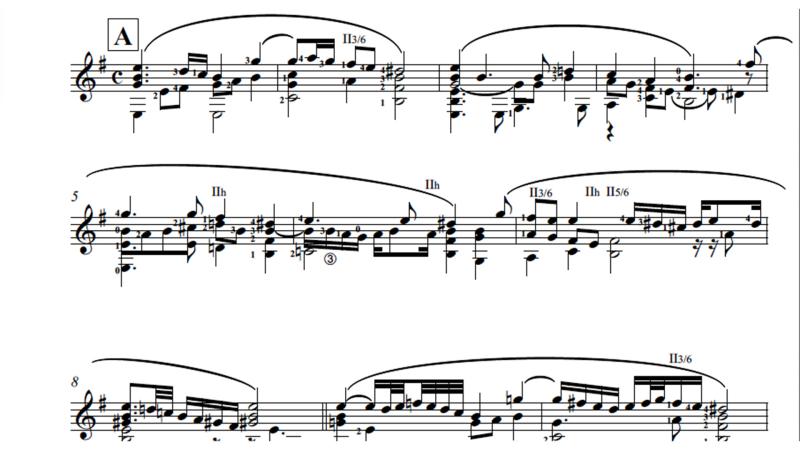How to Identify Voices in Guitar Music
Identifying voices in guitar music is an analysis skill all guitarists should develop. Classical guitar music is often quite congested because it contains multiple voices on a single musical staff.
Developing X-ray vision of the score
This can be difficult to see in the beginning stages of learning. Over time, you will develop a kind of x-ray vision that allows you to see a melodic line in the score even if it is hidden by swarms of other notes.
Voices in SATB Choir Score
To better illustrate what I am talking about, have a look at a musical score written for a choir.

Commonly these scores will be scored for four different voice types: Soprano, alto, tenor, and bass. Each of these voices has a single line of music dedicated to each part. The four voices are thus visually separated into four distinct parts. As these parts are sung together chords are created and melodies, countermelodies, and harmonic lines intertwine with one another. To follow along with one of these scores is quite easy because you can see the rhythm and contour of each voice.
Voices in Classical Guitar Score
Classical guitar music will also feature multiple voices, sometimes moving independently of one another, sometimes creating harmony and melody. But the crucial difference is that these voices, of which there are sometimes up to four, are all squashed onto the one musical staff making it quite challenging to decipher. To make matters even more challenging, many voices on the guitar will drop out or feature partial lines because of inherent limitations of our instrument.

Homophonic Voice Texture
The best thing you can do to improve your x-ray vision is to start playing musical voices in isolation. The easiest starting point is to find a melody in a homophonic texture. Homophony simply means that there is a melody with harmonic accompaniment. So, if you were to strum a guitar and sing, for example, that would be a homophonic texture. In the classical repertoire this texture is common and you will find an upper melody with an accompaniment of arpeggiated chords. Here’s an example from one of Schubert’s Lieder:

In a homophonic setting for guitar the melody will often be clarified with stem direction that all go in the same direction.

Start by playing this upper melody on its own, without the accompaniment. You will find that even the most obvious of melodic lines will benefit from being played in isolation. Why? It frees up your technique to focus completely on phrasing the music.
Singing each voice in isolation
Singing individual voices can also provide an incredibly instructive way to hear the music and access your musicality. Even though you may not be the world’s greatest singer, you will find that bypassing the fingers and the guitar entirely will allow you to be more instinctive and intuitive with your musical shaping. If you are a beginner guitarist, then the difference between your ability to play expressively on the guitar and sing expressively will be even more pronounced. Play around with your voice until you find a phrasing that you like and then try and replicate it on the guitar.
Inner Voices
As you become more experienced with classical guitar music you will be able to identify not only upper melodies but also bass and inner voice melodies. Ultimately you should aim to be able to recognize musical lines simply by looking at the score. Your goal should be identifying the connection between notes that reside in the middle of stacked harmonies.
***
Identifying voices in classical guitar music is an analysis skill that will benefit you at every level. From bringing out a melody to pulling out a subtle inner voice, paying closer attention to voices will boost your interpretations. Go here to learn more about multiple voices or polyphony in music.
We hope you’ve enjoyed this article! Want to see other lessons on musicianship and interpretation? Check out this article on 7 ways to create a musical interpretation.

Leave A Comment